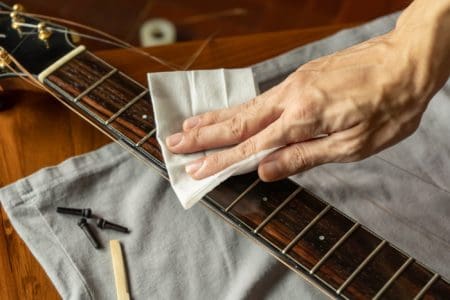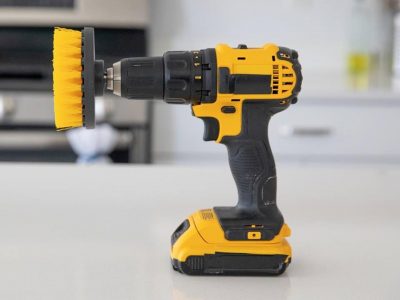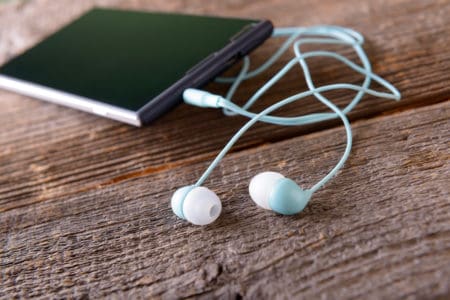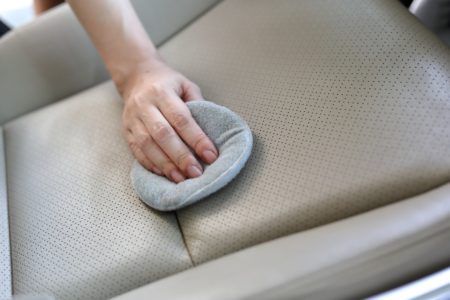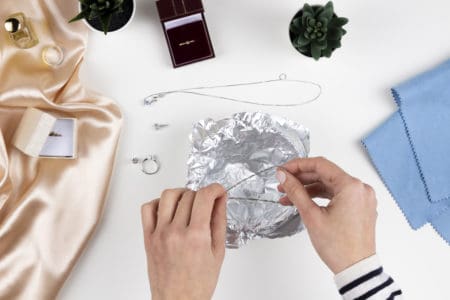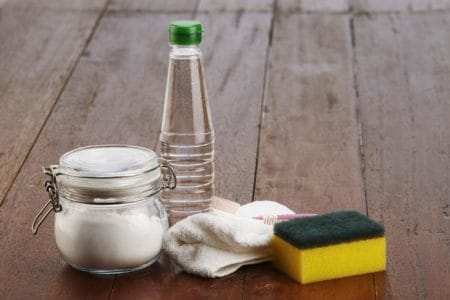Is your guitar starting to look dirty and grimy, like it needs to be cleaned? Then you’ve come to the right place. Today we’re discussing how to clean a guitar at home and what to clean a guitar with so that you don’t damage it.
Soon your guitar will be shining like new and begging for you to play it.
Key Takeaways
- Clean your guitar once or twice a year with a slightly damp cloth and proper guitar cleaning products.
- Avoid using household items that contain strong chemicals, instead use white vinegar or fretboard lemon oil (not on maple fretboards).
- Distinguish between finished and unfinished fretboards, as well as the type of wood before cleaning to avoid damage.
- In addition to the fretboard and body, clean the guitar’s hardware like the bridge, tuning keys, and pickups.
How Often Should You Clean Your Guitar?
Under normal usage, guitars should be thoroughly cleaned once or twice a year. If you are playing for hours under hot stage lights, you will be leaving sweat and oil on your guitar. As a result, your guitar will need to be cleaned more often.
What Can I Use to Clean My Guitar?
The finish on a guitar is delicate and can be easily damaged if you use the wrong products on it, so typically people use guitar cleaning products such as guitar cleaners and polishes to deep clean their guitar.
You can also wipe your guitar down with a damp cloth. Ensure that the cloth is not soaking wet as too much water will damage your guitar.
Household Items For Guitar Cleaning
Most household items are not recommended for use when you’re cleaning guitars. The reason is that they contain alcohol, ammonia, a heavy wax, bleach, silicon, or another strong chemical that will damage the finish.
However, white vinegar may be used to clean your guitar. Do not apply the vinegar directly to your guitar. Use a clean cloth to apply the vinegar instead.
Guitar Polish Alternatives
Fretboard lemon oil should be used to clean the fretboard as it’s designed to safely clean most fretboards without damaging them. However, if you have a maple fretboard do not use fretboard lemon oil. It may discolor the wood. Also remember that this is different to pure lemon oil, which should not be used as it can damage your fretboard.
Lighter fluid may also be used to clean your guitar, but you must make sure you use it in a ventilated area away from flames. Again, do not put the lighter fluid directly on your guitar. Instead, moisten the cloth and use the cloth to clean your guitar.
How to Clean a Guitar Fretboard
You will need to know whether you have a finished fretboard or an unfinished fretboard before you begin. An unfinished fretboard has no lacquer or protective coating on the wood whereas a finished fretboard does.
Also, you will need to know what type of fretboard your guitar has before you begin to clean your guitar. A maple fretboard can easily be discolored or damaged. If yours is an unfinished maple fretboard you will need to make sure that the cleaner or oil you use is appropriate so that you do not cause any damage to it..
The fretboard only needs to be cleaned once or twice a year to remove the dirt. However, the fretboard benefits from the natural oils and moisture on your clean skin, so you don’t want to wash all the oils away.
- Time: 30 minutes
- Difficulty: Beginner
Unfinished Fretboards
What You Need
- 2-3 Microfiber cloths
- Fretboard guard
- Ultrafine steel wool (0000 grade)
- Old toothbrush (optional)
- Masking tape or painter’s tape
- Guitar cleaner, oil, or polish
- Compressed air
1. Wash Hands
Before you begin cleaning your maple fretboard, wash your hands. This will help to prevent any dirt on your hands from getting on your guitar.
2. Remove Strings
It’s best to remove the strings on your guitar before you clean the fretboard. This will make it easier for you to clean.
3. Clean the Fretboard
Use a damp cloth to clean the fretboard and the neck. Make sure that the cloth is not too wet. Work gently to rub all the gunk off of the guitar.
If there’s a lot of gunk on your fretboard, use ultrafine steel wool to clean it. Before you begin, cover the pickups with masking tape or painter’s tape. This will prevent the magnets in the pickups from attracting the steel wool shavings. Don’t worry, the ultrafine steel wool will not damage your frets.
Gently rub at the gunk with a circular motion until it’s gone. You can use an old toothbrush to remove the gunk as well. The steel wool has the added benefit of polishing the frets as you clean the fretboard.
When you’ve finished, blow the steel wool away using compressed air. Make sure to blow it away from the pickups. Then, use a clean, dry microfiber cloth to wipe your guitar’s fretboard clean of all the shavings.
4. Oil the Fretboard
Use a guitar cleaner or oil to oil your fretboard. Use a clean cloth to apply a small amount to your fretboard and neck. Keep in mind that too much conditioner may warp the neck.
Maple fretboards are easily discolored. So make sure that the cleaner or oil you use does not have any lemon oil in it, and that it’s safe for a maple fretboard.
5. Clean the Neck
If the neck of your guitar is finished, clean it with a damp cloth. If it’s unfinished, oil it with the guitar cleaner or oil that you used in step 4.
You’ll want to use a clean microfiber cloth for each step so you don’t spread dirt from one section of your guitar to another.
Finished Fretboards
Finished fretboards should not be cleaned with steel wool or an old toothbrush. They have the potential of scratching the finish. Instead, you’ll use water to clean the fretboard.
What You Need
- 3-4 Microfiber cloths
- Fret guard
- Ultrafine steel wool (0000 grade) -used to polish the fret
- Masking tape (If using steel wool)
- White vinegar
1. Wash Hands
Wash your hands before you begin cleaning your fretboard to prevent oil and dirt from getting on your guitar.
2. Remove Strings
Remove the strings of your guitar. This will not only make it easier to clean your fretboard but will also prevent you from getting any oil or cleaners on your strings.
3. Clean the Fretboard
Use a damp microfiber cloth to gently scrub your fretboard. Work in circular motions.
You can also use a guitar cleaner or lemon oil to clean your fretboard provided you don’t have a maple fretboard. Most maple fretboards are finished, but can still be discolored or damaged if you use the wrong cleaners on them. So always make sure that you’re using a guitar cleaner that’s safe for maple.
To clean your fretboard with a guitar cleaner, first, dampen the microfiber cloth with the guitar cleaner and then use the cloth to scrub the fretboard.
4. Polish the Frets
Cover your pickups with masking tape or painter’s tape. This will prevent any steel wool shavings from being attracted to the magnets in the pickups.
Then, place the fretboard guard over one fret. Use the ultrafine steel wool to polish the fret without damaging your fretboard. Polish each fret by moving the fretboard guard to each fret and then using the steel wool to polish it.
Use compressed air to blow away the shavings. Make sure that you blow the steel wool shavings away from the pickups. Then wipe your guitar down with a clean and dry microfiber cloth to make sure that all the shavings are gone.
4. Wipe Down the Neck
Wipe down the neck using a clean slightly damp cloth or the guitar cleaner to remove any dirt and grime. You want to use a new cloth with each step to prevent transferring dirt from one part of the guitar to another.
How to Clean and Polish a Guitar Body
Cleaning and polishing a guitar body is easier than cleaning the fretboard and neck. However, you will still need to consider the type of finish that the body of your guitar has.
Poly-Finishes
The poly-finishes are the most common type of finish that guitars have and provide a glossy look to the guitar. It’s an easy type of finish to clean so you can use almost any type of polish or cleaner that’s made for guitars.
Spray the guitar cleaner onto a clean microfiber cloth. Then rub the cloth over the length of your guitar to clean it. Make sure to clean the front, sides, and back of your guitar.
Rinse out your cloth as you work or use a clean cloth. This will prevent you from spreading dirt from one area of the guitar to another area.
If a smudge doesn’t come off, you can breathe deeply on the smudge. Then wipe with your damp cloth.
When the guitar is clean, you have the option of applying a coat of guitar wax that’s 100% carnauba wax to your guitar to make it shine.
Nitrocellulose Finishes
Be careful when cleaning a guitar with a nitrocellulose finish. It’s an old-fashioned porous finish that’s rarely used these days. Also, a nitrocellulose finish develops a sheen or patina as it ages.
This makes the guitar more valuable, so you’ll need to be careful not to remove the sheen or patina as you clean the body of your guitar.
It’s best not to use cleaners or polishes on your guitar. Instead, use a lightly damp cloth to gently wipe it down and remove fingerprints.
Matte and Satin Finishes
Do not attempt to use damp cloths, cleaners, or polishes on a matte or satin-finished guitar. These types of finishes leave a hazy finish that practically lets you touch the wood of the guitar.
Instead, wipe your guitar down with a dry microfiber cloth to clean it.
How to Clean a Guitar’s Hardware
In addition to cleaning the fretboard and the body of the guitar, you will also need to clean the guitar’s hardware. These include the bridge, tuning keys, and pickups.
Bridge
Clean the bridge the same way you clean the fretboard. Use a lightly damp cloth to wipe off any dirt and grime you see on the bridge. If there’s a lot of dirt, you can use an old toothbrush or even a pipe cleaner to gently rub it away.
Tuning Keys
Wipe down the turning keys at the top of the guitar. If needed, you can spray a glass cleaner on a cloth and use that to wipe the keys until they shine.
Pickups
Pickups are located on an electric guitar. You can use a lightly damp cloth to clean any dirt or dust you see on them.
If you see rust on the pickups, you will need to remove the pickups from your guitar. Then clean them with a rust-dissolving agent like wd-40. When the rust is removed, return the pickups to your guitar.
Use a dry cloth to wipe the pickups clean.
Cleaning Acoustic Vs Electric Guitars
There’s very little difference between cleaning an acoustic and an electric guitar. The biggest difference is that acoustic guitars rarely have a maple fretboard, so you can use a guitar cleaner to clean the fretboards. Another difference is that electric guitars include pickups that will need to be cleaned.
Otherwise, you use the same cleaning methods to clean both an acoustic and electric guitar.
Extra Guitar Cleaning Tips
- It’s best to use clean microfiber cloths or wiping cloths. Paper towels or regular washcloths may scratch the finish.
- Use a clean cloth for each step of the process. This will ensure that you’re not mixing products as you clean and prevents you from spreading dirt to clean parts of your guitar.
- Don’t spray your cleaner directly on your guitar. Always spray it on the cloth first and then use the cloth to apply the cleaner to the guitar.
- Use cleaners that are meant for cleaning guitars. Many regular household cleaners are too strong for use on a guitar and will damage the finish.
- Don’t clean your guitar too often as the polish can dampen the sound quality of your instrument.
- Only use a slightly damp cloth on your guitar. Too much liquid may cause the wood to warp.
How to Keep a Guitar Clean
Wash your hands first. This will help prevent any oils, grease, and grime that you pick up throughout the day from getting on your guitar.
Wipe down your guitar with a clean microfiber cloth before you put it away, so you can keep sweat and dirt from accumulating on your guitar.
Clean your strings periodically using a cleaning lubricant designed for guitar strings. The lubricant will help to keep your fretboard clean as well.
Always store your guitar in its case to prevent dust from gathering on your guitar.
